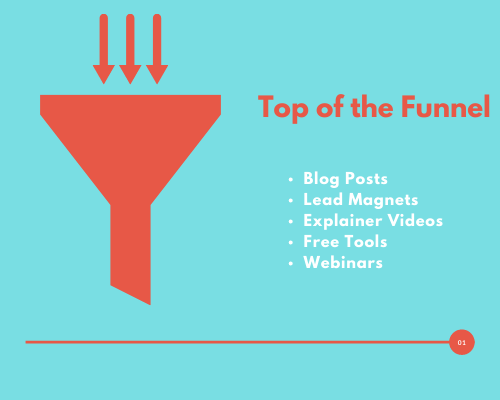For most marketers, content helps drive more traffic to their funnel, but there’s more to it.
Content marketing is a major part of any viable sales funnel. In fact, a study by SEMrush revealed the following:
- 86% of marketers develop MOFU (middle-of-the-funnel MOFU) content
- 95% develop TOFU (top-of-the-funnel) content
- 76% develop BOFU (middle-of-the-funnel) content
While creating more content, awareness content has gained popularity over time, a good number of marketers also use other forms of content at the decision-making and consideration stages.
At the end of the day, you need different content for each stage. Someone ready to purchase right away will require different information from a new prospect that just discovered their need.
That being said, these tips will help you when it comes to crafting content for every of your funnel.

Awareness (TOFU)
The prospect’s journey begins the moment they enter the funnel. This might be completely different if your business is eCommerce related due to impulse buying, but the statement is correct for B2B businesses.
This is the stage where the prospect starts searching for solutions. Maybe they are not making enough sales, or they are not getting repeat customers.
It’s important to know that they probably know nothing about you or your brand at this stage. You need to expose them to content that addresses their problem and proffers a solution.
Examples of top-of-the-funnel (TOFU) content
-
Blog Posts
Blogging remains the holy grail of any content marketing strategy. For most marketers, blogging is critical, and research shows that marketers who blog generate 13 times more ROI than people who don’t.
With blogging, you can address the pain points of your prospects directly. Also, you will be able to narrow down specific topics. For instance, Hubspot puts the average blog post length at 2,100 to 2,400 words, which is enough to cover any niche topic in detail.
Using the right keywords in your blog posts will help you get more traffic from the search engines – but you shouldn’t be relying on this alone. You should also give your blogs more exposure through social (paid, organic, or even both), pay-per-click marketing, and email marketing.
-
Lead Magnets
While blogs help increase brand awareness, you can give out lead magnets in exchange for prospects’ information.
There are different forms of lead magnets. The common ones are downloadable ebooks, videos, or infographics.
Research shows that video-based lead magnets convert better than their text-based counterparts (24.2% against 22.8%), while infographics and free tools both have a conversion rate of around 11.8%.
It’s important that you choose a lead magnet that is unique in some ways. That way, people will be more likely to hand over their email addresses and phone numbers.
-
Walk-through Videos
The idea of teaching prospects how to solve their problems may sound strange, but walk-through videos work like magic at the TOFU, with about 53% of marketers in agreement that video increases their brand awareness. They are effective because:
- You can demonstrate how your products help solve their problem
- Your prospects will learn the true value of your product and use it to solve their problem themselves
- Your willingness to explain how your prospects can solve their problems goes further to prove your trustworthiness and credibility.
Also, it’s important to know that video content performs exceptionally on social, getting more eyeballs on your brand. Video gets 6.13% more engagement on Facebook than any other type of content.
-
Free Tools
If you can develop a free tool that solves a specific problem for your prospects, it can be vital in your sales process, because your prospects will continue to access it again and again.
You don’t have to develop the tool from scratch. It could be a free/mini version of the main product. For example, Ahrefs’ free backlink checker allows you to see the number of links pointing to a URL or domain but doesn’t give you access to all the premium experience of the full package.
By developing a valuable free tool, you can keep your brand in the mind of your target audience when they are about to make a purchasing decision.
-
Webinars
Webinars have become widely used in TOFU-related content, and about 53% of marketers plan to add them to their video marketing arsenal – an impressive 11% increase from the previous year.
That is not a surprise though, because 75% of B2B marketers report getting quality leads from webinars.
Why do webinars work so well?
Live webinars are interactive and engaging. Whereas videos and ebooks do not allow audience participation, your prospects can ask questions during live webinars and you can interact with them in real-time, which makes them an effective way to grow their brand.

Consideration: Middle of the funnel
Your prospect has given you their attention; it’s now time to move them into the middle of the funnel.
The prospects in this stage accept that they need a solution to their problem, and they have a picture of the type of solution they want in their head. Now, they are in search of the perfect solution.
While prospects’ education takes place at the top of the funnel, the demonstration stage is where you show them why your product is what they need to solve their problem.
Examples of middle-of-the-funnel (MOFU) content
-
Case Studies
About 13% of marketers reveal that ‘case studies’ form a major part of their content strategy. This means they rank 5th on the list of the most popular types of content.
With case studies, you can demonstrate how your product has solved a similar problem faced by your prospects. However they shouldn’t be seen as some blocks of text containing benefits and features. Rather, case studies are meant to tell a story, highlighting the problem one of your customers struggled with, how they found your product, and their result after applying it. Deployed correctly, your prospects should be able to picture themselves in the shoes of your customer, getting a similar result.
-
Product Comparisons
The MOFU isn’t just called the consideration stage for nothing. It’s because your prospects are probably weighing up several options.
Subsequently, comparison content – a write-up that pitches the strengths and weaknesses of your product or brand against that of your competitors – is priceless at this stage.
Of course, you’ll speak in favour of your product. But you can still be objective as much as possible.
Start by establishing why your product is the perfect choice for your potential buyer. For instance, if you’re targeting fast-growing start-ups, while your competitors are focusing on well-established businesses, you can address its scalability and flexibility. And since you are not focusing on established businesses, it’s only fair to state that your competitors are better at serving those types of businesses.

Decision- Making: Bottom-of-the-Funnel
Once your prospects land at the bottom of the sales funnel, they are ready to buy
Well, it doesn’t mean you will close the sale. But you sure have a chance.
Ideally, you need to gently persuade the leads at this stage of the funnel. Combining a solid call to action with the right content can go a long way.
Examples of Bottom-of-the-funnel (BOFU) content
-
No-risk Trials
With free trials, prospects can test out your product. This is particularly common in SaaS products, and they exist in one of two forms.
- Time-based: prospects are given full product for a certain period.
- Capability-based: prospects are given partial access to a few features for a long time.
At the end of the day, the goal is to get them to pay for the full access after using the free or limited version.
-
Product Demos
Free trials don’t work for every brand.
If prospects are required to learn how to use your product, you will need more than free trials to do that. This is where a product demo excels.
We can categorise free trials into two primary groups:
Video demo: a video created to highlight the features of the product.
Live demo: here a spokesperson interacts with the prospects, showing them the benefits and features of your product
Sometimes, the prospect might request a comprehensive live demo after watching a video demo.
-
No-cost Consultations
Some companies don’t have a product. If you offer services, you may want to consider a free consultation in place of a free or demo trial.
Consultations are more effective because they give out immense value. Marketing agencies are good at using this tactic. They might map out content strategy or offer to do a full SEO audit for prospects’ websites.
Ideally, no one wants to give their product away for free. Whatever you come up with, it should offer value to your prospects, while still giving them reasons to purchase your service.
Want to know how to build the perfect marketing and sales funnel for your business?
If you want to get more sales and build your business and are looking for an affordable marketing agency in Melbourne and Sydney with expertise in marketing and sales funnel development, then get in touch with the experts at Bright Owl Marketing.









